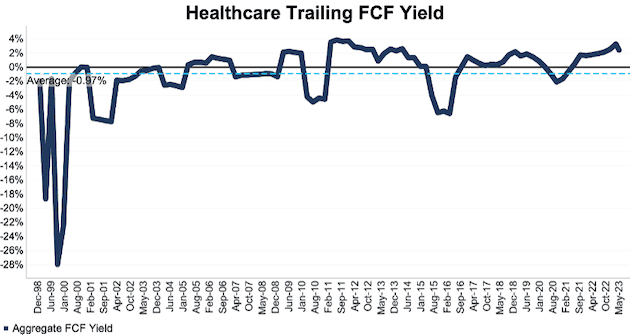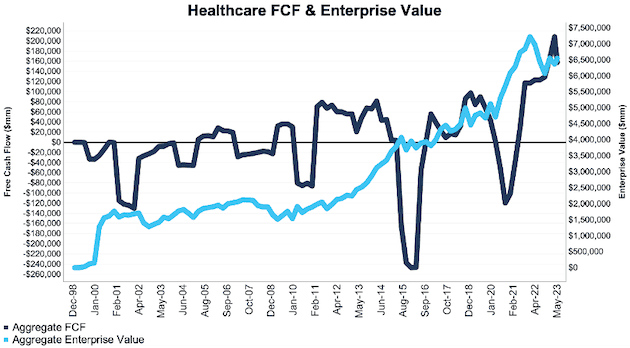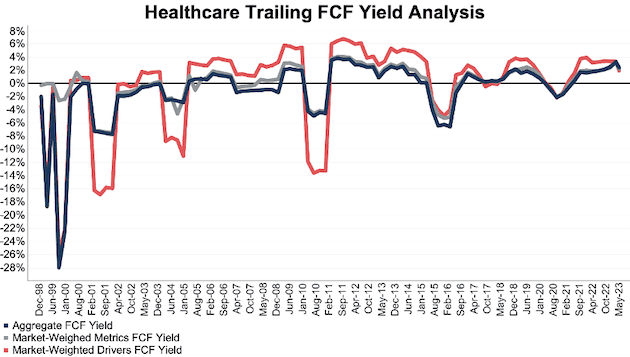The NC 2000’s free cash flow (FCF) yield remains well above its long-term average at its highest levels since 9/30/14.
At the sector level, there are mixed signals to be sure. Some sectors are seeing FCF and FCF Yields go up while others see them plummet – and to varying degrees. See our full report for details.
This report is an abridged and free version of All Cap Index & Sectors: Free Cash Flow Yield Is Flat Through 5/15/23, one of our quarterly reports on fundamental market and sector trends.
The full version of this report analyzes[1],[2] free cash flow, enterprise value, and the trailing FCF yield for the NC 2000 and each of its sectors (last quarter’s analysis is here). The full reports are available to our Professional and Institutional members or can be purchased below.
This report leverages our cutting-edge Robo-Analyst technology to deliver proven-superior[3] fundamental research and support more cost-effective fulfillment of the fiduciary duty of care.
NC 2000 Trailing FCF Yield Remains Flat in 1Q23
The trailing FCF yield for the NC 2000 remained flat at 2.3%[4] from 3/31/23 to 5/15/23.
See Figure 1 in the full version of our report for the chart of FCF Yield for the NC 2000 from December 1998 through 5/15/23.
Five NC 2000 sectors saw an increase in trailing FCF yield from 3/31/23 to 5/15/23.
Key Details on Select NC 2000 Sectors
With a 14.4% FCF Yield, investors are getting the highest FCF for their investment dollar in the Telecom Services sector as of 5/15/23. On the flip side, the Utilities sector, at -2.6%, currently has the lowest trailing FCF yield of all NC 2000 sectors.
The Telecom Services, Industrials, Energy, Consumer Cyclicals, and Technology sectors each saw an increase in trailing FCF yield from 3/31/23 to 5/15/23.
Below, we analyze the Healthcare sector's trailing FCF yield.
Sample Sector Analysis: Healthcare[5]
Figure 1 shows the trailing FCF yield for the Healthcare sector fell from 3.3% as of 3/31/23 to 2.4% as of 5/15/23. The Healthcare sector’s FCF fell from $208.1 billion in 4Q22 to $157.4 billion in 1Q23, while enterprise value rose from $6.4 trillion as of 3/31/23 to $6.5 trillion as of 5/15/23.
Figure 1: Healthcare Trailing FCF Yield: Dec 1998 – 5/15/23
Sources: New Constructs, LLC and company filings.
The May 15, 2023 measurement period uses price data as of that date and incorporates the financial data from 1Q23 10-Qs, as this is the earliest date for which all of the 1Q23 10-Qs for the NC 2000 constituents were available.
Figure 2 compares the trends in FCF and enterprise value for the Healthcare sector since 1998. We sum up the individual NC 2000/sector constituent values for free cash flow and enterprise value. We call this approach the “Aggregate” methodology, and it matches S&P Global’s (SPGI) methodology for these calculations.
Figure 2: Healthcare FCF & Enterprise Value: Dec 1998 – 5/15/23
Sources: New Constructs, LLC and company filings.
The May 15, 2023 measurement period uses price data as of that date and incorporates the financial data from 1Q23 10-Qs, as this is the earliest date for which all of the 1Q23 10-Qs for the NC 2000 constituents were available.
The Aggregate methodology provides a straightforward look at the entire NC 2000/sector, regardless of market cap or index weighting, and matches how S&P Global (SPGI) calculates metrics for the S&P 500.
For additional perspective, we compare the Aggregate method for free cash flow with two other market-weighted methodologies. Each method has its pros and cons, which are detailed in the Appendix.
Figure 3 compares these three methods for calculating the Healthcare sector’s trailing FCF yields.
Figure 3: Healthcare Trailing FCF Yield Methodologies Compared: Dec 1998 – 5/15/23
Sources: New Constructs, LLC and company filings.
The May 15, 2023 measurement period uses price data as of that date and incorporates the financial data from 1Q23 10-Qs, as this is the earliest date for which all of the 1Q23 10-Qs for the NC 2000 constituents were available.
This article was originally published on June 7, 2023.
Disclosure: David Trainer, Kyle Guske II, and Italo Mendonça receive no compensation to write about any specific stock, style, or theme.
Questions on this report or others? Join our Society of Intelligent Investors and connect with us directly.
Appendix: Analyzing Trailing FCF Yield with Different Weighting Methodologies
We derive the metrics above by summing the individual NC 2000/sector constituent values for free cash flow and enterprise value to calculate trailing FCF yield. We call this approach the “Aggregate” methodology.
The Aggregate methodology provides a straightforward look at the entire NC 2000/sector, regardless of market cap or index weighting, and matches how S&P Global (SPGI) calculates metrics for the S&P 500.
For additional perspective, we compare the Aggregate method for free cash flow with two other market-weighted methodologies. These market-weighted methodologies add more value for ratios that do not include market values, e.g. ROIC and its drivers, but we include them here, nonetheless, for comparison:
- Market-weighted metrics – calculated by market-cap-weighting the trailing FCF yield for the individual companies relative to their sector or the overall NC 2000in each period. Details:
- Company weight equals the company’s market cap divided by the market cap of the NC 2000/ its sector
- We multiply each company’s trailing FCF yield by its weight
- NC 2000/Sector trailing FCF yield equals the sum of the weighted trailing FCF yields for all the companies in NC 2000/sector
- Market-weighted drivers – calculated by market-cap-weighting the FCF and enterprise value for the individual companies in each sector in each period. Details:
- Company weight equals the company’s market cap divided by the market cap of the NC 2000/ its sector
- We multiply each company’s free cash flow and enterprise value by its weight
- We sum the weighted FCF and weighted enterprise value for each company in the NC 2000/each sector to determine each sector’s weighted FCF and weighted enterprise value
- NC 2000/Sector trailing FCF yield equals weighted NC 2000/sector FCF divided by weighted NC 2000/sector enterprise value
Each methodology has its pros and cons, as outlined below:
Aggregate method
Pros:
- A straightforward look at the entire NC 2000/sector, regardless of company size or weighting.
- Matches how S&P Global calculates metrics for the NC 2000.
Cons:
- Vulnerable to impact of companies entering/exiting the group of companies, which could unduly affect aggregate values. Also susceptible to outliers in any one period.
Market-weighted metrics method
Pros:
- Accounts for a firm’s market cap relative to the NC 2000/sector and weights its metrics accordingly.
Cons:
- Vulnerable to outlier results from a single company disproportionately impacting the overall trailing FCF yield.
Market-weighted drivers method
Pros:
- Accounts for a firm’s market cap relative to the NC 2000/sector and weights its free cash flow and enterprise value accordingly.
- Mitigates the disproportionate impact of outlier results from one company on the overall results.
Cons:
- More volatile as it adds emphasis to large changes in FCF and enterprise value for heavily weighted companies.
[1] We calculate these metrics based on S&P Global’s (SPGI) methodology, which sums up the individual NC 2000 constituent values for free cash flow and enterprise value before using them to calculate the metrics. We call this the “Aggregate” methodology.
[2] Our research is based on the latest audited financial data, which is the 1Q23 10-Q in most cases. Price data is as of 5/15/23.
[3] Our research utilizes our Core Earnings, a more reliable measure of profits, as proven in Core Earnings: New Data & Evidence, written by professors at Harvard Business School (HBS) & MIT Sloan and published in The Journal of Financial Economics.
[4] Note that 2.3% is lower than the 2.7% reported in last quarter’s report because the more recent 2.3% captures more companies, specifically the companies that filed 10-Ks or 10-Qs after the “as of” cutoff date for the last report.
[5] The full version of this report provides a complete analysis of all other sectors of the NC 2000.



